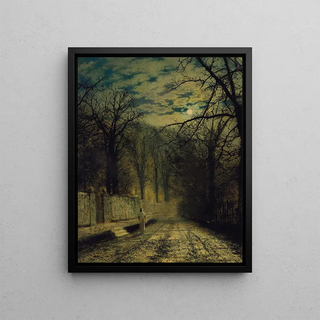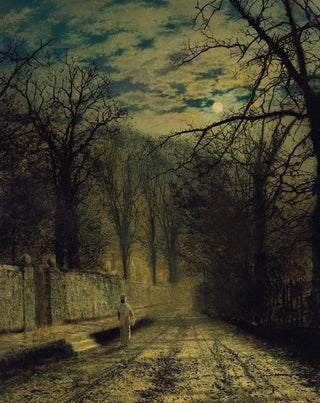Art print | A Moonlit Street - John Atkinson Grimshaw Source: Reproduction | Une rue au clair de lune - John Atkinson Grimshaw


View from behind

Frame (optional)
In the enchanting world of art, some works manage to capture the very essence of an atmosphere, of a time period. "Une rue au clair de lune" by John Atkinson Grimshaw is a shining example. This painting, bathed in soft and mysterious light, evokes a nighttime stroll through an English city of the 19th century. The scene, imbued with serenity, transports the viewer to a world where time seems suspended. The shadows dance under the silvery glow of the moon, revealing subtle details that invite exploration. Grimshaw, through his undeniable talent, succeeds in creating an ambiance that is both nostalgic and dreamlike, allowing everyone to escape and feel the magic of the night.
Style and uniqueness of the work
John Atkinson Grimshaw's style is characterized by an exceptional mastery of light and color. In "Une rue au clair de lune," he uses shades of blue and silver to evoke the freshness of the night, while touches of yellow and orange warm the scene, like lanterns illuminating the path. The composition is carefully balanced, with architectural elements standing out against the night background. The trees, majestic and almost spectral, add a poetic dimension to the whole, while the reflections on the wet cobblestones create an illusion of depth and movement. This attention to detail and ability to capture the evanescence of the moment make this work a masterpiece of Victorian realism, where every brushstroke seems to tell a story.
The artist and his influence
John Atkinson Grimshaw, born in 1836 in Leeds, is often associated with the Pre-Raphaelite movement, although he developed a style that is uniquely his own. His fascination with nocturnal light and urban landscapes led him to explore themes rarely addressed by his contemporaries. Grimshaw was able to combine a keen sense of observation with poetic sensitivity, thus influencing many artists who followed him. His unique approach to landscape painting paved the way for a new appreciation of the beauty of urban nights. Through

Matte finish

View from behind

Frame (optional)
In the enchanting world of art, some works manage to capture the very essence of an atmosphere, of a time period. "Une rue au clair de lune" by John Atkinson Grimshaw is a shining example. This painting, bathed in soft and mysterious light, evokes a nighttime stroll through an English city of the 19th century. The scene, imbued with serenity, transports the viewer to a world where time seems suspended. The shadows dance under the silvery glow of the moon, revealing subtle details that invite exploration. Grimshaw, through his undeniable talent, succeeds in creating an ambiance that is both nostalgic and dreamlike, allowing everyone to escape and feel the magic of the night.
Style and uniqueness of the work
John Atkinson Grimshaw's style is characterized by an exceptional mastery of light and color. In "Une rue au clair de lune," he uses shades of blue and silver to evoke the freshness of the night, while touches of yellow and orange warm the scene, like lanterns illuminating the path. The composition is carefully balanced, with architectural elements standing out against the night background. The trees, majestic and almost spectral, add a poetic dimension to the whole, while the reflections on the wet cobblestones create an illusion of depth and movement. This attention to detail and ability to capture the evanescence of the moment make this work a masterpiece of Victorian realism, where every brushstroke seems to tell a story.
The artist and his influence
John Atkinson Grimshaw, born in 1836 in Leeds, is often associated with the Pre-Raphaelite movement, although he developed a style that is uniquely his own. His fascination with nocturnal light and urban landscapes led him to explore themes rarely addressed by his contemporaries. Grimshaw was able to combine a keen sense of observation with poetic sensitivity, thus influencing many artists who followed him. His unique approach to landscape painting paved the way for a new appreciation of the beauty of urban nights. Through






